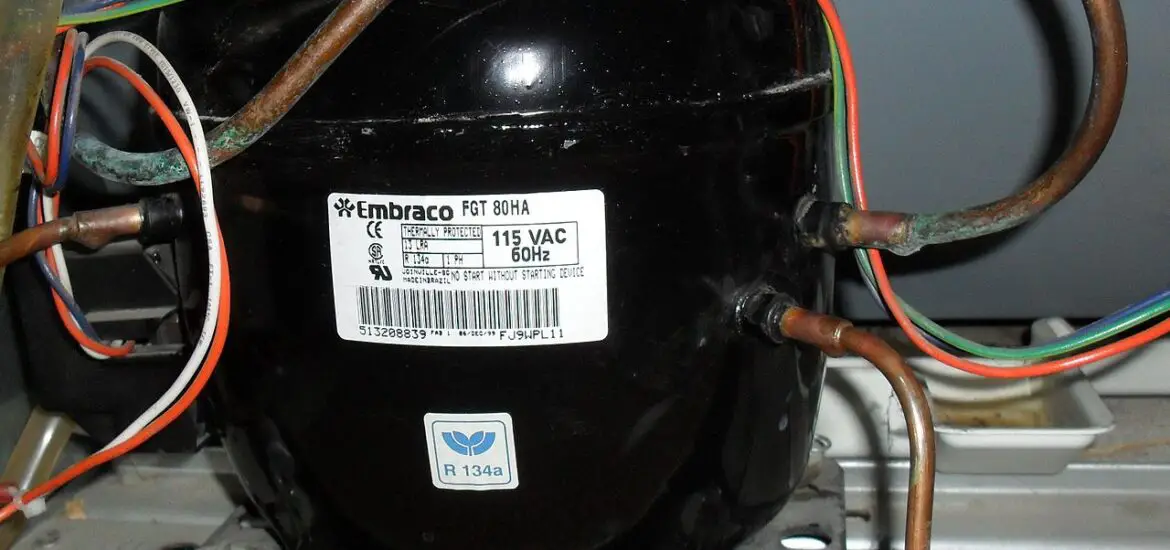You know how it goes, right? One day your fridge is chillin’, keeping your veggies crisp and your ice cream perfect. The next day, it seems more like a slightly cool pantry. Sounds like your refrigerator compressor could do with some recharging. In this article, we’ll provide you with a handy guide on how to recharge refrigerator compressor. Are you up for it? Then, let’s get started.

Table of Contents
Understanding Your Refrigerator Compressor
Your refrigerator’s unsung hero is the compressor. It’s the heart of the cooling process, circulating refrigerant that picks up heat from inside and expels it outside. Sometimes, the refrigerant levels drop and the compressor needs recharging.
The Role of the Compressor
Imagine the compressor as a magic sponge. It soaks up the warmth from your fridge and wrings it out into the room, keeping your food cool. But what if the sponge dries up? That’s where the refrigerant comes in – it’s the lifeblood of your compressor.
Signs of a Low Refrigerant Level
How do you know if your compressor needs a boost? Well, your food might start going off more quickly, or the fridge might make strange noises like it’s straining to stay cool. It’s time to recharge, dear friend!
Safety Precautions Before Recharging Your Compressor
Before we dive into the recharging process, we have to talk about safety. We’re dealing with refrigerant gases here, folks, so let’s stay safe, okay?
Required Safety Gear
Think of this as a DIY project with a twist. Just like any other project, you’ll need some gear – gloves, safety glasses, and a well-ventilated space. Trust me, your eyes and skin will thank you!
Refrigerant Handling Guidelines
Refrigerant isn’t something to mess around with. It’s a potent greenhouse gas, so be sure not to release it into the atmosphere. It’s not just me saying this – it’s the law, according to the Environmental Protection Agency (EPA).
Tools Needed to Recharge Your Refrigerator Compressor
Ready to get your hands dirty? Before you start, let’s get your toolkit in order.
Refrigerant
Most home fridges use a refrigerant called R-134a. You’ll need this to recharge your compressor, so make sure you’ve got it ready. Remember what we said about safety, though – handle it with care.
Refrigerant Recharging Kit
Next up, you’ll need a refrigerant recharging kit. It’s like a first aid kit for your compressor – it’s got all the essentials for recharging, from a pressure gauge to a service valve and a charging pipe.
Additional Tools
And of course, you’ll need the basics. A wrench and screwdriver should do the trick. Easy peasy, right?
Check out these other related articles…
Refrigerator Compressor Cold to Touch: Reasons & Solutions
Compressor Fridge vs 3 Way Fridge: An In-depth Comparison
Refrigerator Compressor Function: All You Need to Know
Refrigerator Compressor Temperature: Your Essential Guide
Refrigerator Compressor Terminals: Your Comprehensive Guide
How to Check Refrigerator Compressor Relay: A Detailed Guide
Step-by-Step Guide to Recharging Your Refrigerator Compressor
Now we’re getting to the juicy part. Ready to bring your compressor back to life? Follow these steps and you’ll have it purring like a kitten in no time.
Locating the Compressor
First things first – let’s find that compressor. Look behind your fridge – see that black, tank-like thing? That’s your compressor.
Compressor Types
Compressors come in different shapes and sizes, but they all do the same job. Whether it’s a scroll, rotary, or reciprocating compressor, you’ll find it at the back of your fridge.
Connecting the Recharging Kit
Now it’s time to connect your recharging kit. Take it slow, follow the instructions on the kit, and you’ll be fine.
Precautions to Take When Connecting
Remember, safety first. Make sure your fridge is unplugged, and don’t force the connections – you don’t want to damage the compressor or the kit.
Recharging the Compressor
Okay, the moment of truth. Open the valve on your recharging kit and let the refrigerant flow into the compressor. But hold on, how much should you add?
Understanding the Correct Amount of Refrigerant
Too much or too little refrigerant can mess up your compressor. The right amount depends on your fridge’s specifications, so check the user manual or consult the manufacturer’s website.
Post-Recharging Steps
Congratulations! You’ve recharged your compressor. But before you start celebrating, let’s wrap things up properly.
Testing the Refrigerator
Now plug in your fridge and let it run for a few hours. Then check the temperature – is it back to its cool, crisp self? If so, you’ve nailed it!
Disposal of Used Refrigerant
Got leftover refrigerant? Don’t just chuck it in the bin. The EPA has guidelines for how to dispose of it safely. So, check the official EPA website for these guidelines. Let’s keep our planet green, shall we?
When to Seek Professional Help
If at any point things get hairy, or if you’re not comfortable doing this yourself, call in a pro. Remember, it’s better safe than sorry. Plus, an experienced technician can check for other potential issues, saving you trouble down the line.
